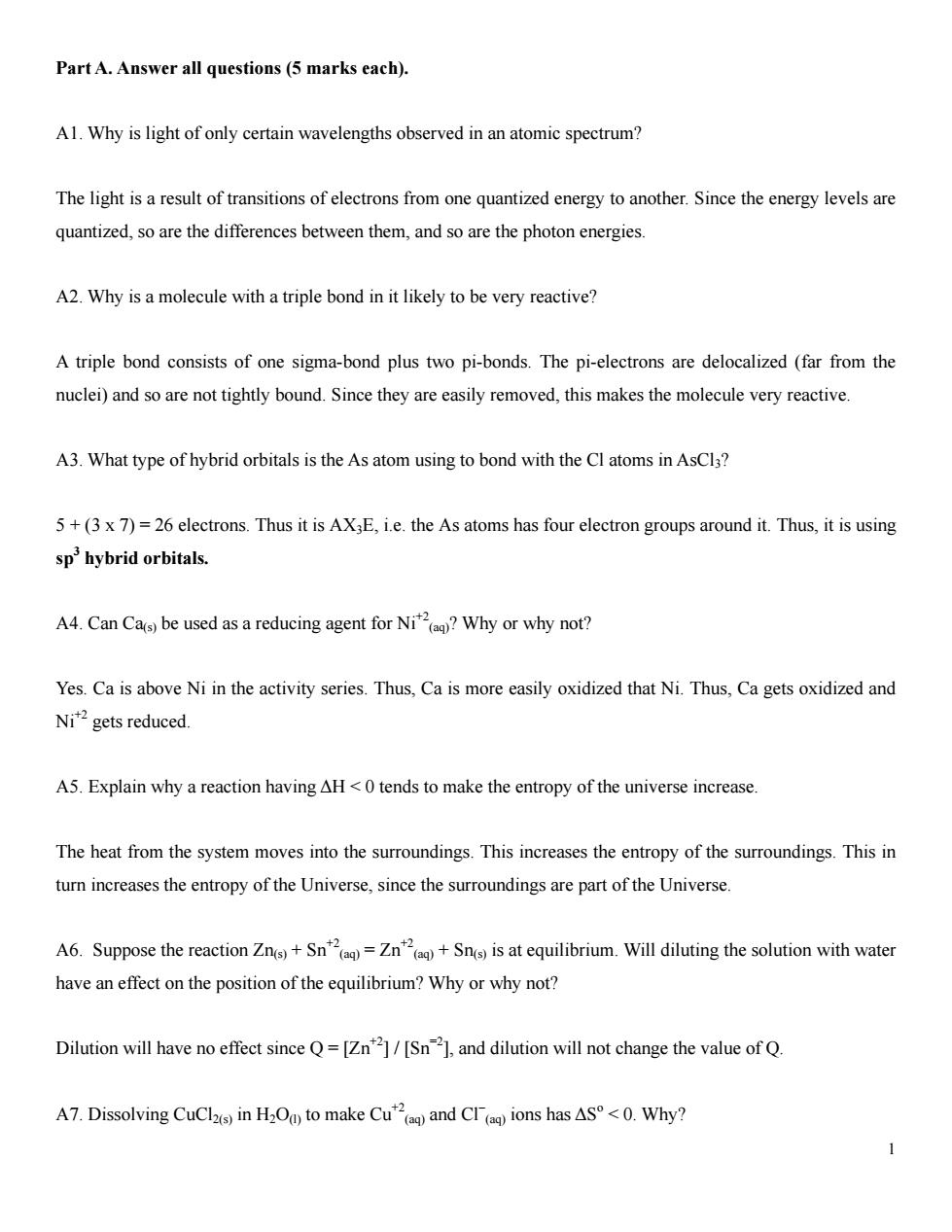
Part A.Answer all questions(5 marks each) A1.Why is light of only certain wavelengths observed in an atomic spectrum? The light is a result of transitions of electrons from one quantized energy to another.Since the energy levels are quantized,so are the differences between them,and so are the photon energies. A2.Why is a molecule with a triple bond in it likely to be very reactive? A triple bond consists of one sigma-bond plus two pi-bonds.The pi-electrons are delocalized (far from the nuclei)and so are not tightly bound.Since they are easily removed,this makes the molecule very reactive. A3.What type of hybrid orbitals is the As atom using to bond with the Cl atoms in AsCl3? 5+(3x7)=26 electrons.Thus it is AXE,i.e.the As atoms has four electron groups around it.Thus,it is using sphybrid orbitals A4.Can Cas be used as a reducing agent for Ni?Why or why not? Yes.Ca is above Ni in the activity series.Thus,Ca is more easily oxidized that Ni.Thus,Ca gets oxidized and Nigets reduced. A5.Explain why a reaction having AH<tends to make the entropy of the universe increase. The heat from the system moves into the surroundings.This increases the entropy of the surroundings.This in turn increases the entropy of the Universe,since the surroundings are part of the Universe. A6.Suppose the reaction Zn+Sn=Zn+Sn(s)is at equilibrium.Will diluting the solution with water have an effect on the position of the equilibrium?Why or why not? Dilution will have no effect since Q=[Zn][Sn]and dilution will not change the value ofQ A7.Dissolving CuCls in HO to make Cu and Cl ions has AS<0.Why?
1 Part A. Answer all questions (5 marks each). A1. Why is light of only certain wavelengths observed in an atomic spectrum? The light is a result of transitions of electrons from one quantized energy to another. Since the energy levels are quantized, so are the differences between them, and so are the photon energies. A2. Why is a molecule with a triple bond in it likely to be very reactive? A triple bond consists of one sigma-bond plus two pi-bonds. The pi-electrons are delocalized (far from the nuclei) and so are not tightly bound. Since they are easily removed, this makes the molecule very reactive. A3. What type of hybrid orbitals is the As atom using to bond with the Cl atoms in AsCl3? 5 + (3 x 7) = 26 electrons. Thus it is AX3E, i.e. the As atoms has four electron groups around it. Thus, it is using sp3 hybrid orbitals. A4. Can Ca(s) be used as a reducing agent for Ni+2 (aq)? Why or why not? Yes. Ca is above Ni in the activity series. Thus, Ca is more easily oxidized that Ni. Thus, Ca gets oxidized and Ni+2 gets reduced. A5. Explain why a reaction having ΔH < 0 tends to make the entropy of the universe increase. The heat from the system moves into the surroundings. This increases the entropy of the surroundings. This in turn increases the entropy of the Universe, since the surroundings are part of the Universe. A6. Suppose the reaction Zn(s) + Sn+2 (aq) = Zn+2 (aq) + Sn(s) is at equilibrium. Will diluting the solution with water have an effect on the position of the equilibrium? Why or why not? Dilution will have no effect since Q = [Zn+2] / [Sn=2], and dilution will not change the value of Q. A7. Dissolving CuCl2(s) in H2O(l) to make Cu+2 (aq) and Cl− (aq) ions has ΔSo < 0. Why?

Although the ions in CuCl have low entropy,making the aqueous ions reduces the entropy of the associated water molecules even more. A8.CuCla(s spontaneously dissolves in water even though AS<0.Why? Because△H°<0 A9.Why are the ionization potentials of phosphorus(P)and sulphur(S)approximately equal? P has three unpaired p-electrons.Although S has four,and the fourth should be more easily removed since it is paired with one other,thus decreasing the ionization potential,the S atom also has one more proton,making the effective nuclear charge greater,increasing the ionization potential.The net effect is no change. Part B.Answer all questions on this page(20 marks total). BI.Ammonium nitrate can be used as an explosive.It decomposes according to NH4NO3g→N2g+2HOg+⅓O2e Assuming the gases behave ideally,calculate the total volume of the products at 300C and 1 atm when 12.0 g of ammonium nitrate decomposes. 12g 80g/mol =0.15 mol NH NO x 3.5 mol gas mol NHaNO3 =0.525 mol gas V-RT0.525 mol(0.082Latm mol-K300+273)K247L p 1atm B2.A sample of an unknown gas diffuses in 11.1 minutes.An equal volume of H2dg)in the same apparatus under 2
Although the ions in CuCl2(s) have low entropy, making the aqueous ions reduces the entropy of the associated water molecules even more. A8. CuCl2(s) spontaneously dissolves in water even though ΔSo < 0. Why? Because ΔHo < 0 A9. Why are the ionization potentials of phosphorus (P) and sulphur (S) approximately equal? P has three unpaired p-electrons. Although S has four, and the fourth should be more easily removed since it is paired with one other, thus decreasing the ionization potential, the S atom also has one more proton, making the effective nuclear charge greater, increasing the ionization potential. The net effect is no change. Part B. Answer all questions on this page (20 marks total). B1. Ammonium nitrate can be used as an explosive. It decomposes according to: NH4NO3(s) → N2(g) + 2 H2O(g) + ½ O2(g). Assuming the gases behave ideally, calculate the total volume of the products at 300o C and 1 atm when 12.0 g of ammonium nitrate decomposes. g . mol NH NO g / mol ⎛ ⎞ ⎜ ⎟ = ⎝ ⎠ 4 3 12 0 15 80 x 3.5 mol gas / mol NH4NO3 = 0.525 mol gas nRT . mol( . L atm mol K )( )K V . p atm − − + = = = 1 1 0 525 0 082 300 273 24 7 1 L B2. A sample of an unknown gas diffuses in 11.1 minutes. An equal volume of H2(g) in the same apparatus under 2
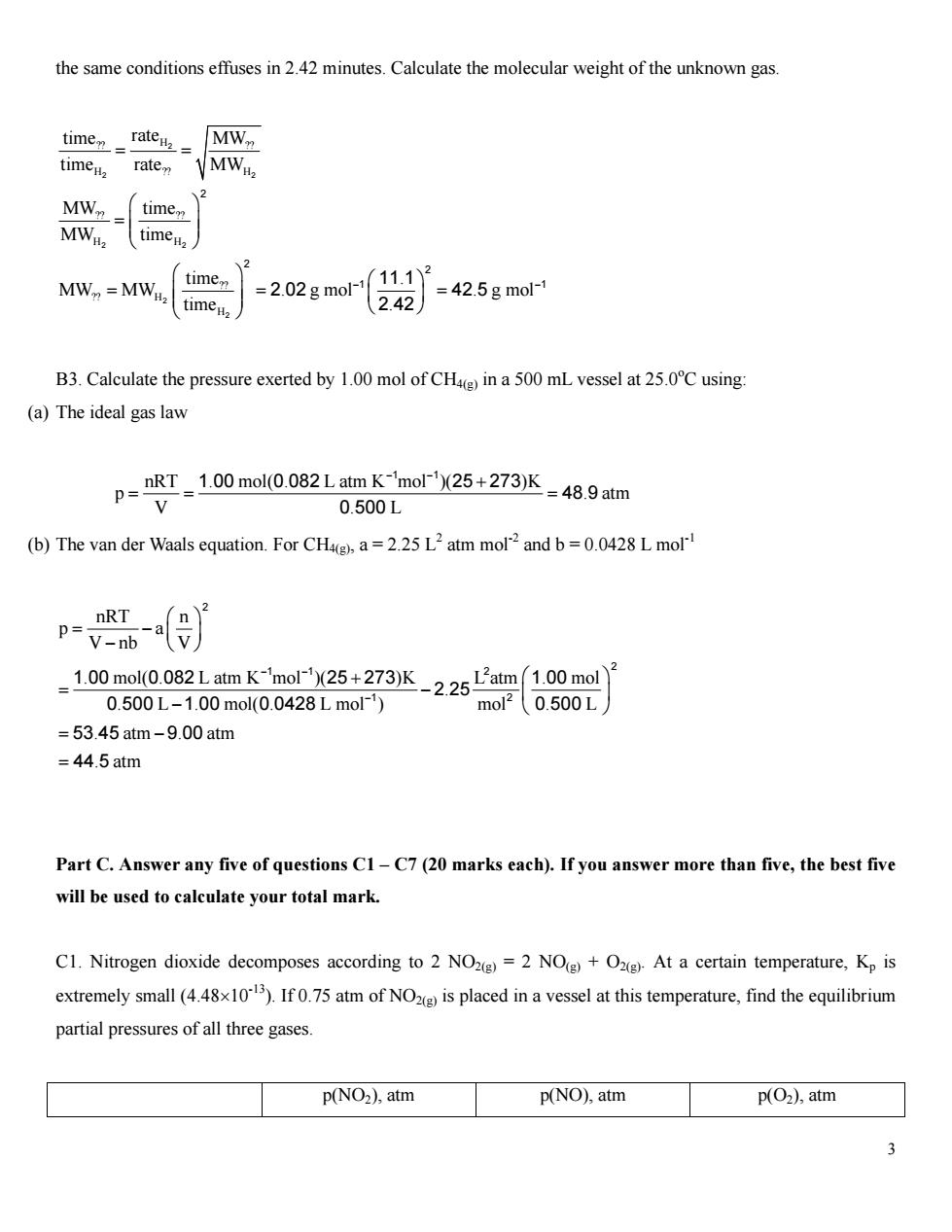
the same conditions effuses in 2.42 minutes.Calculate the molecular weight of the unknown gas. time raten MW MW timen MW,气time, time =2.02gmol1 11.1)2 =42.5 g mol- timeu 2.42 B3.Calculate the pressure exerted by 1.00 mol of CH ina 500 mL vessel at 25.0Cusing (a)The ideal gas law nRT 1.00 mol(.082Latm K-'molX25+273)K.9 atm P= 0.500L (b)The van der Waals equation.For CH4)a=2.25 L2atm mol2 and b=0.0428 L mol p=- 1.00 mol(0.082 Latm K-'mol-25+273)KLatm1.00 mol 0.500L-1.00mol(0.0428Lmol) mo20.500L =53.45atm-9.00atm =44.5atm Part C.Answer any five of questions C1-C7(20 marks each).If you answer more than five,the best five will be used to calculate your total mark. C1.Nitrogen dioxide decomposes according to 2 NO2)=2 NO)+Ox()At a certain temperature,Kp is extremely small(4.48x).If0.75 atm of NO is placed in a vessel at this temperature,find the equilibrium partial pressures of all three gases p(NOz).atm p(NO),atm p(O2),atm 3
the same conditions effuses in 2.42 minutes. Calculate the molecular weight of the unknown gas. ?? H ?? H ?? H ?? ?? H H ?? ?? H H time rate MW time rate MW MW time MW time time . MW MW . g mol . g mol time . − − = = ⎛ ⎞ = ⎜ ⎟ ⎜ ⎟ ⎝ ⎠ ⎛ ⎞ ⎛ ⎞ == = ⎜ ⎟ ⎜ ⎟ ⎜ ⎟ ⎝ ⎠ ⎝ ⎠ 2 2 2 2 2 2 2 2 2 2 1 1 11 1 2 02 42 5 2 42 B3. Calculate the pressure exerted by 1.00 mol of CH4(g) in a 500 mL vessel at 25.0o C using: (a) The ideal gas law nRT . mol( . L atm K mol )( )K p . V . L − − + = = = 1 1 1 00 0 082 25 273 48 9 0 500 atm (b) The van der Waals equation. For CH4(g), a = 2.25 L2 atm mol-2 and b = 0.0428 L mol-1 nRT n p a V nb V . mol( . L atm K mol )( )K L atm . mol . . L . mol( . L mol ) mol . L . atm . atm . atm − − − ⎛ ⎞ = − ⎜ ⎟ − ⎝ ⎠ + ⎛ ⎞ = − ⎜ ⎟ − ⎝ ⎠ = − = 2 2 1 1 2 1 2 1 00 0 082 25 273 1 00 2 25 0 500 1 00 0 0428 0 500 53 45 9 00 44 5 Part C. Answer any five of questions C1 – C7 (20 marks each). If you answer more than five, the best five will be used to calculate your total mark. C1. Nitrogen dioxide decomposes according to 2 NO2(g) = 2 NO(g) + O2(g). At a certain temperature, Kp is extremely small (4.48×10-13). If 0.75 atm of NO2(g) is placed in a vessel at this temperature, find the equilibrium partial pressures of all three gases. p(NO2), atm p(NO), atm p(O2), atm 3
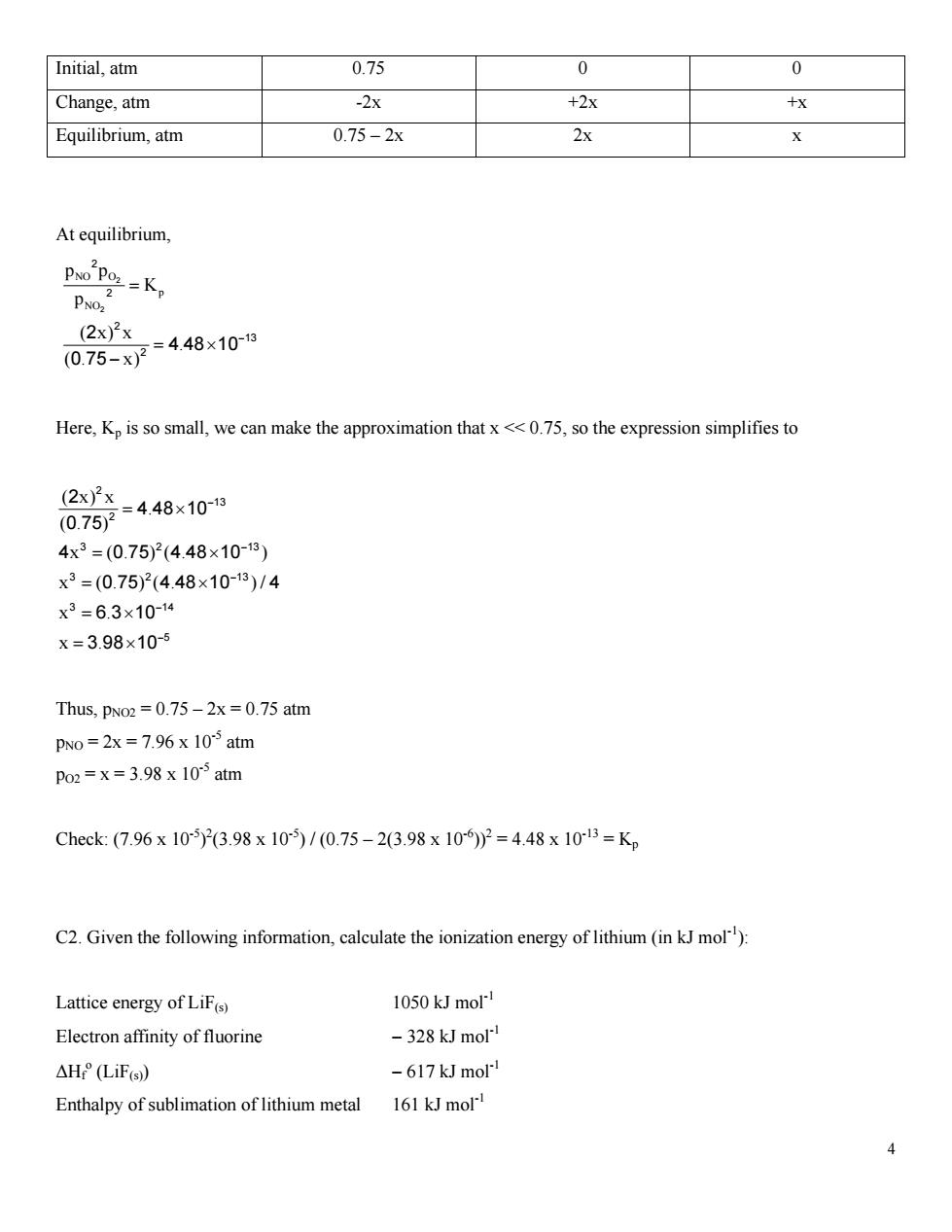
Initial,atm 0.75 0 0 Change,atm -2x +2x +x Equilibrium,atm 0.75-2x 2x Atequilibrium. Pso Po=K PNo,2 (0.75-X7=448x103 (2x)2x Here,Kp is so small,we can make the approximation that x<<0.75,so the expression simplifies to 075=4.48x10-9 (2x)2x 4x3=(0.75)2(4.48×10-13) x3=(0.75)2(4.48×10-13)/4 x3=6.3×10-14 x=3.98×10-5 Thus,pNo2=0.75-2x=0.75 atm pw0=2x=7.96x103atm Po2=x=3.98 x 105 atm Check:(7.96x102(3.98x10)/(0.75-2(3.98x102=4.48x1013=K C2.Given the following information,calculate the ionization energy of lithium(in kJmol): Lattice energy of LiF(s) 1050 kJ mol! Electron affinity of fluorine -328 kJ mol △H°(Lifs) -617 kJ mol Enthalpy of sublimation of lithium metal 161 kJ mol
Initial, atm 0.75 0 0 Change, atm -2x +2x +x Equilibrium, atm 0.75 – 2x 2x x At equilibrium, NO O p NO p p K p ( x) x . ( . x) − = = × − 2 2 2 2 2 13 2 2 4 48 10 0 75 Here, Kp is so small, we can make the approximation that x << 0.75, so the expression simplifies to ( x) x . (. ) x (. )( . ) x ( . ) ( . )/ x . x . − − − − − = × = × = × = × = × 2 13 2 32 1 32 13 3 14 5 2 4 48 10 0 75 4 0 75 4 48 10 0 75 4 48 10 4 6 3 10 3 98 10 3 Thus, pNO2 = 0.75 – 2x = 0.75 atm pNO = 2x = 7.96 x 10-5 atm pO2 = x = 3.98 x 10-5 atm Check: (7.96 x 10-5) 2 (3.98 x 10-5) / (0.75 – 2(3.98 x 10-6))2 = 4.48 x 10-13 = Kp C2. Given the following information, calculate the ionization energy of lithium (in kJ mol-1): Lattice energy of LiF(s) 1050 kJ mol-1 Electron affinity of fluorine − 328 kJ mol-1 ΔHf o (LiF(s)) − 617 kJ mol-1 Enthalpy of sublimation of lithium metal 161 kJ mol-1 4
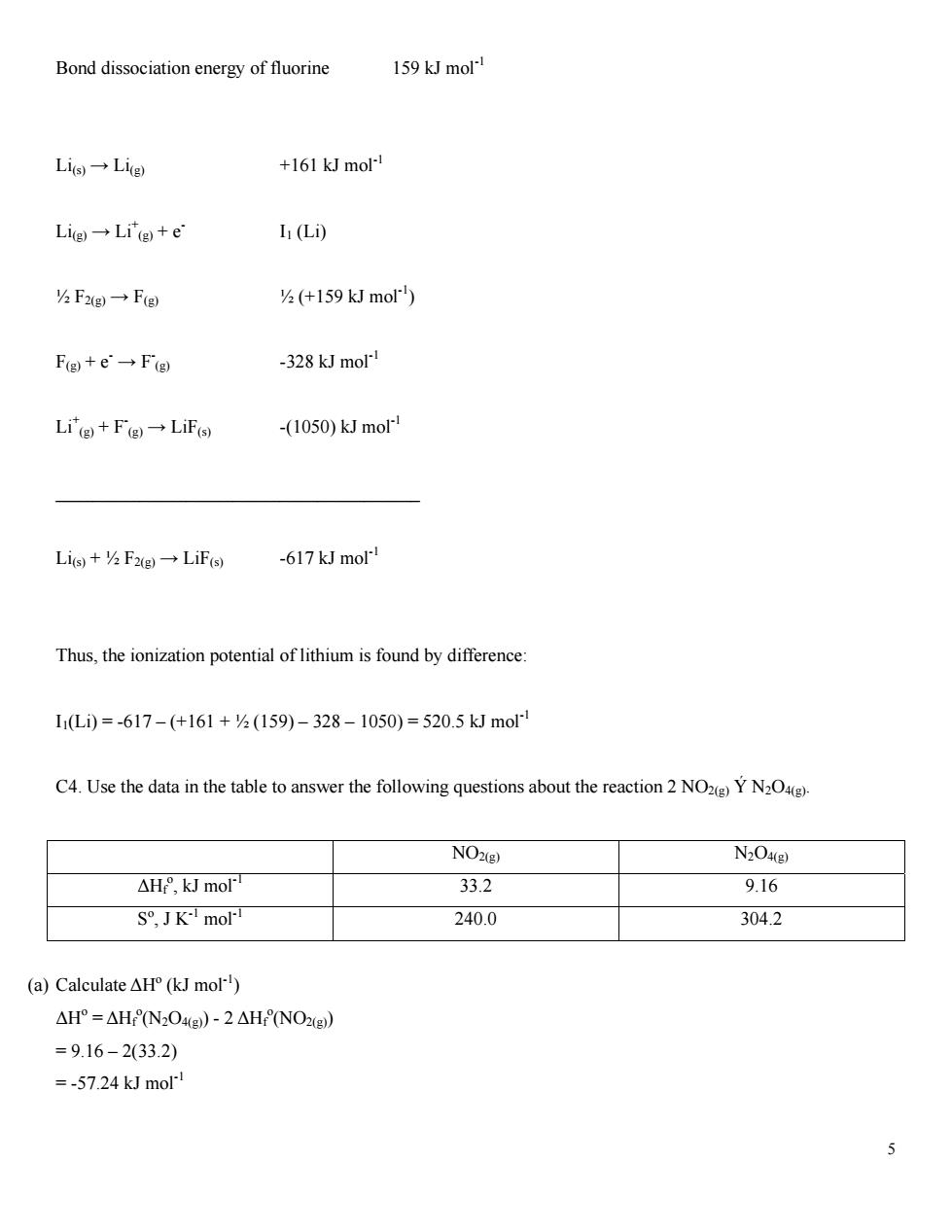
Bond dissociation energy of fluorine 159 kJ mol! Lig→Lie +161 kJ mol Lig→Litg+e I (Li) hFg→Fg 2(+159kmol) Fg+e→Fg -328 kJ mor Li计g+Fg)一LiFo -(1050)kJ mol Li6+⅓F2g→Lifo -617 kJ mol Thus,the ionization potential of lithium is found by difference: 11(Li)=-617-(+161+⅓(159)-328-1050)=520.5 kJ mol C4.Use the data in the table to answer the following questions about the reaction 2) NO2(g) N204g △H,kJ molT 33.2 9.16 S°,JK-mo 240.0 304.2 (a)Calculate AH(kJ mol) △Hr°=△HN204He)-2AHNO2e) =9.16-233.2) =-57.24 kJ mol
5 Bond dissociation energy of fluorine 159 kJ mol-1 Li(s) → Li(g) +161 kJ mol-1 Li(g) → Li+ (g) + e- I1 (Li) ½ F2(g) → F(g) ½ (+159 kJ mol-1) F(g) + e- → F- (g) -328 kJ mol-1 Li+ (g) + F- (g) → LiF(s) -(1050) kJ mol-1 _______________________________________ Li(s) + ½ F2(g) → LiF(s) -617 kJ mol-1 Thus, the ionization potential of lithium is found by difference: I1(Li) = -617 – (+161 + ½ (159) – 328 – 1050) = 520.5 kJ mol-1 C4. Use the data in the table to answer the following questions about the reaction 2 NO2(g) Ý N2O4(g). NO2(g) N2O4(g) ΔHf o , kJ mol-1 33.2 9.16 So , J K-1 mol-1 240.0 304.2 (a) Calculate ΔHo (kJ mol-1) ΔHo = ΔHf o (N2O4(g)) - 2 ΔHf o (NO2(g)) = 9.16 – 2(33.2) = -57.24 kJ mol-1
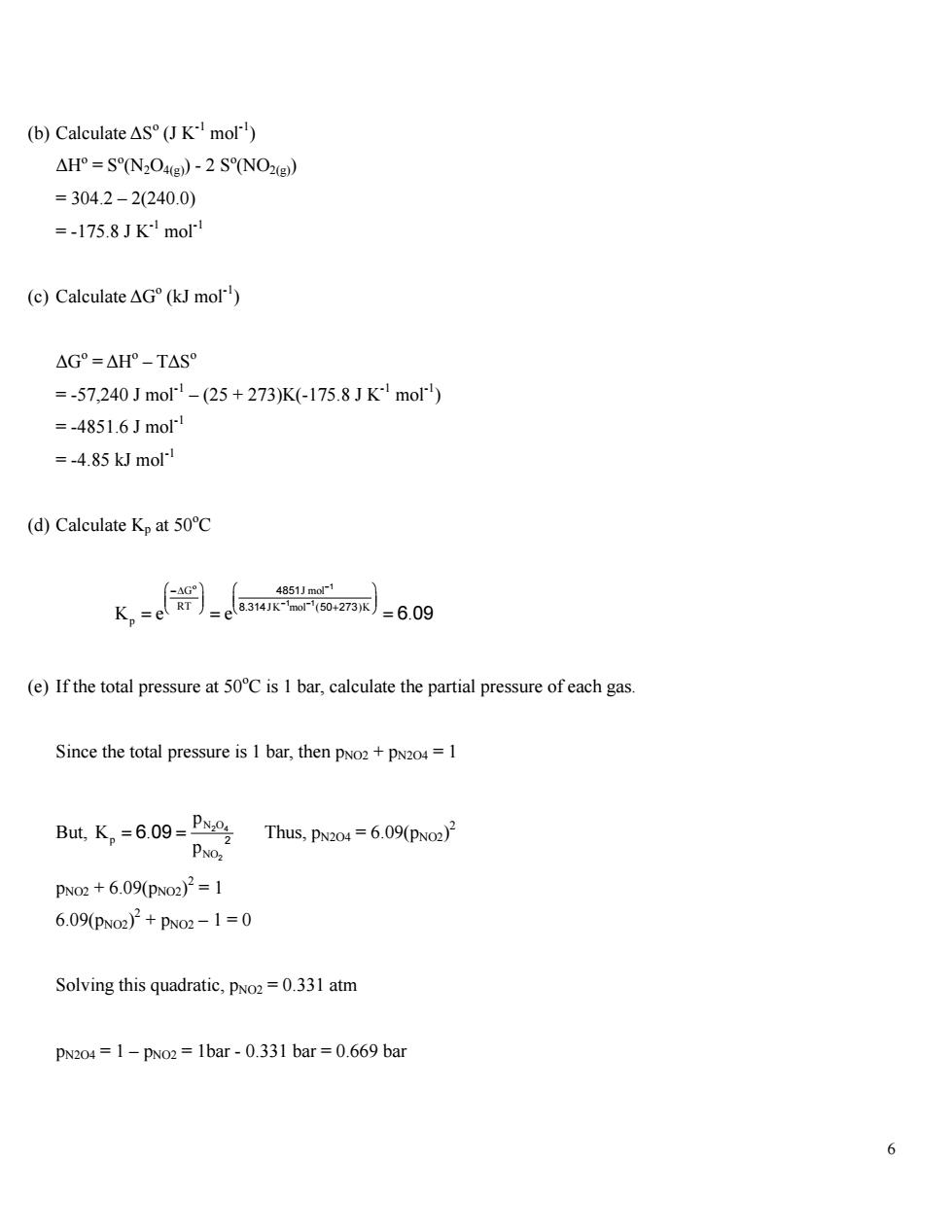
(b)Calculate△s°(JK-mol') △H=SN,04e)-2SNO2g) =304.2-2(240.0) =-175.8 JK*mol (c)Calculate AG(kJ mol) △G=△H°-T△S =-57,240Jmo-(25+273)K(-175.8JK-mol =-4851.6Jmol =-4.85kmo (d)Calculate Kp at 50C K,-0.ma60 4851J mol1 (e)If the total pressure at 50C is 1 bar,calculate the partial pressure of each gas Since the total pressure is I bar,then pNo2 +pN2o4=1 ButK。=6.09=Po Thus,PN204=6.09(PNO2)2 PNOz PNo2+6.09(pNo2)2=1 6.09(pNo2)2+pNo2-1=0 Solving this quadratic,pNo2=0.331 atm PN204=1-PNO2=1bar-0.331 bar =0.669 bar 6
(b) Calculate ΔSo (J K-1 mol-1) ΔHo = So (N2O4(g)) - 2 So (NO2(g)) = 304.2 – 2(240.0) = -175.8 J K-1 mol-1 (c) Calculate ΔGo (kJ mol-1) ΔGo = ΔHo – TΔSo = -57,240 J mol-1 – (25 + 273)K(-175.8 J K-1 mol-1) = -4851.6 J mol-1 = -4.85 kJ mol-1 (d) Calculate Kp at 50o C o G J mol RT . J K mol ( )K Ke e p . − − − ⎛ ⎞⎛ −Δ ⎞ ⎜ ⎟⎜ ⎟ ⎟ ⎝ ⎠⎝ + ⎠ = = = 1 1 1 4851 8 314 50 273 6 09 (e) If the total pressure at 50o C is 1 bar, calculate the partial pressure of each gas. Since the total pressure is 1 bar, then pNO2 + pN2O4 = 1 But, N O p NO p K . p = = 2 4 2 2 6 09 Thus, pN2O4 = 6.09(pNO2) 2 pNO2 + 6.09(pNO2) 2 = 1 6.09(pNO2) 2 + pNO2 – 1 = 0 Solving this quadratic, pNO2 = 0.331 atm pN2O4 = 1 – pNO2 = 1bar - 0.331 bar = 0.669 bar 6
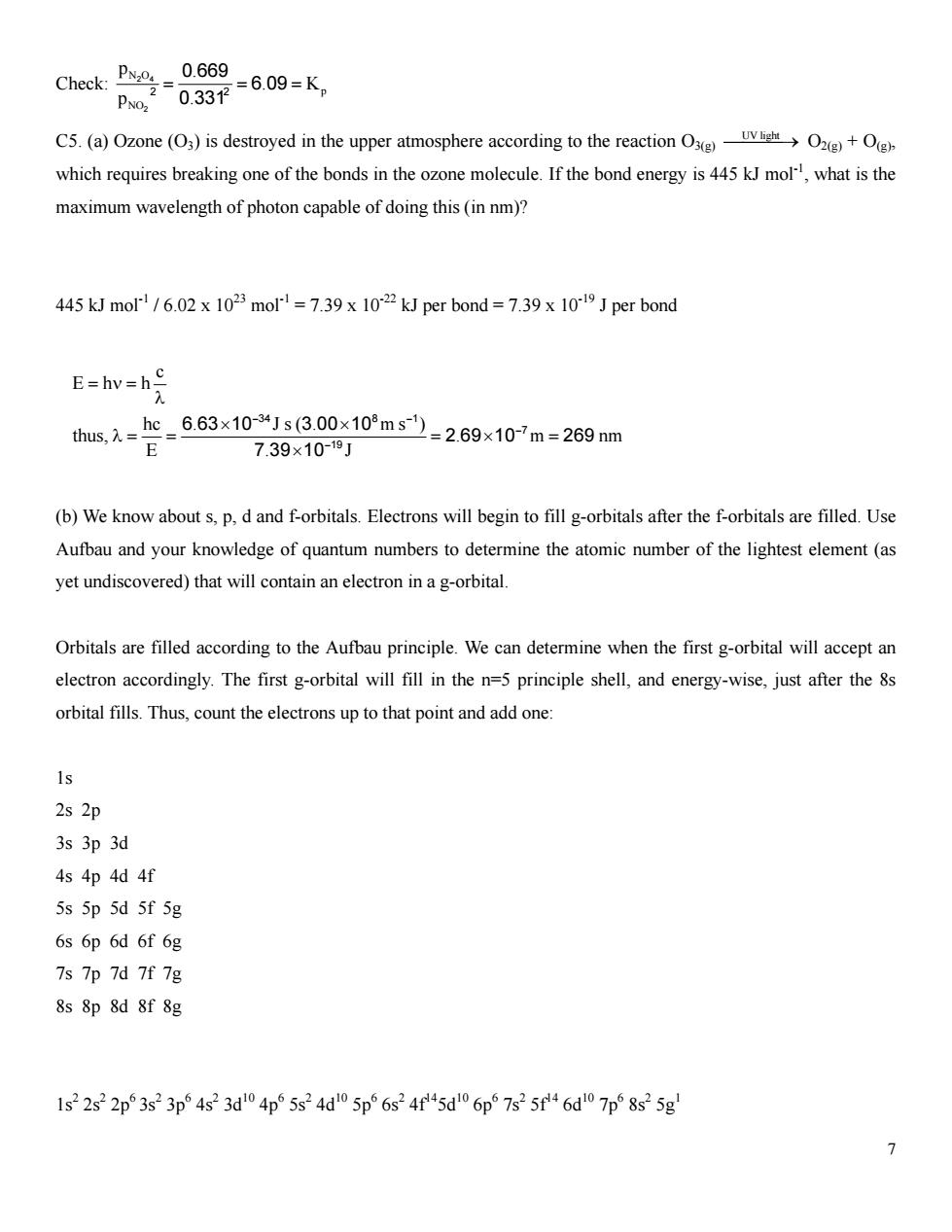
0669-6.09=K。 Check: PNO. C5.(a)Ozone(O3)is destroyed in the upper atmosphere according to the reaction O (g)+O(g). which requires breaking one of the bonds in the ozone molecule.If the bond energy is 445 kJ mol,what is the maximum wavelength of photon capable of doing this(in nm)? 445 kJ mol/6.02x 1023 mol=7.39x 1022 kJ per bond=7.39x1019 J per bond E=hv=h线 hs.X=e-663×1021s30x10ms-269×107m=269nm 7.39×10-19J (b)We know about s,p.d and f-orbitals.Electrons will begin to fill g-orbitals after the f-orbitals are filled.Use Aufbau and your knowledge of quantum numbers to determine the atomic number of the lightest element(as yet undiscovered)that will contain an electron in a g-orbital. Orbitals are filled according to the Aufbau principle.We can determine when the first g-orbital will accept an electron accordingly.The first g-orbital will fill in the n=5 principle shell,and energy-wise,just after the 8s orbital fills.Thus,count the electrons up to that point and add one: 1s 2s 2p 3s 3p 3d 4s 4p 4d 4f 5s 5p 5d 5f 5g 6s 6p 6d 6f 6g 7s Tp 7d 7f 7g 8s 8p 8d 8f 8g 1s22s22p3s23p4s23d04p5s24d05p6s24f45dl06p67s2546dl07p8s25g >
Check: N O p NO p . . K p . = == 2 4 2 2 2 0 669 6 09 0 331 C5. (a) Ozone (O3) is destroyed in the upper atmosphere according to the reaction O3(g) ⎯UV light ⎯⎯→ O2(g) + O(g), which requires breaking one of the bonds in the ozone molecule. If the bond energy is 445 kJ mol-1, what is the maximum wavelength of photon capable of doing this (in nm)? 445 kJ mol-1 / 6.02 x 1023 mol-1 = 7.39 x 10-22 kJ per bond = 7.39 x 10-19 J per bond c Eh h hc . J s ( . m s ) thus, . m nm E .J − − − − = ν= λ × × λ= = = × = × 34 8 1 7 19 6 63 10 3 00 10 2 69 10 269 7 39 10 (b) We know about s, p, d and f-orbitals. Electrons will begin to fill g-orbitals after the f-orbitals are filled. Use Aufbau and your knowledge of quantum numbers to determine the atomic number of the lightest element (as yet undiscovered) that will contain an electron in a g-orbital. Orbitals are filled according to the Aufbau principle. We can determine when the first g-orbital will accept an electron accordingly. The first g-orbital will fill in the n=5 principle shell, and energy-wise, just after the 8s orbital fills. Thus, count the electrons up to that point and add one: 1s 2s 2p 3s 3p 3d 4s 4p 4d 4f 5s 5p 5d 5f 5g 6s 6p 6d 6f 6g 7s 7p 7d 7f 7g 8s 8p 8d 8f 8g 1s2 2s2 2p6 3s2 3p6 4s2 3d10 4p6 5s2 4d10 5p6 6s2 4f145d10 6p6 7s2 5f14 6d10 7p6 8s2 5g1 7

And we see that the 5g electron is number 121,i.e.element 121 will be the lightest element containing this electron. C6.(a)A sample of a gas is at 50C in a 50.0 L container at 1.1 atm.The gas is expanded to 75 L and cooled to 0C.Calculate the new pressure. piV-PaVz TT Thus.P,-P:Vj-1.1atm(5OL)273 K)62atm TV2 (50+273)K(75L) (b)1.00 mol of He under certain conditions exerts a pressure of 5.00 atm.1.00 mol of Cl under the same conditions exerts a lower pressure.Why? Chlorine is a larger molecule than the very small He atoms.Larger molecules have larger attractive forces for one another.Hence the Cl2 molecules are pulled together,reducing the pressure they exert. (c)Calculate the density of Cl at 10.0 atm and 100C(ing/L) p=P(MW) 10 atm(0.070 kg mol-') RT 0.082LamK-m0P100+273K-2.29x10-2kgL'=2,9gL C7.Predict the shapes of the following molecules.Wrong name=zero marks. (a)AsC15-2 Electrons=5+(5x 7)+2=42.Making the five bonds uses 10 of these.Completing the octets on the Cl atoms uses another 30.This leaves two,which are placed as a lone pair on the As atom.Thus the shorthand notation is AXsE.This is a square pyramid. (b)PCIs Electrons=5+(5x 7)=40.Making the five bonds uses 10 of these.Completing the octets on the Cl atoms
And we see that the 5g electron is number 121, i.e. element 121 will be the lightest element containing this electron. C6. (a) A sample of a gas is at 50o C in a 50.0 L container at 1.1 atm. The gas is expanded to 75 L and cooled to 0o C. Calculate the new pressure. pV pV T T pVT . atm( L)( K) Thus, p . atm T V ( ) K ( L) = = = = + 11 2 2 1 2 112 2 1 2 1 1 50 273 0 62 50 273 75 (b) 1.00 mol of He(g) under certain conditions exerts a pressure of 5.00 atm. 1.00 mol of Cl2(g) under the same conditions exerts a lower pressure. Why? Chlorine is a larger molecule than the very small He atoms. Larger molecules have larger attractive forces for one another. Hence the Cl2 molecules are pulled together, reducing the pressure they exert. (c) Calculate the density of Cl2(g) at 10.0 atm and 100o C (in g/L). p(MW) atm( . kg mol ) . kg L . g RT . L atm K mol ( )K − L − − − − − ρ= = = × = + 1 2 1 1 1 10 0 070 2 29 10 22 9 0 082 100 273 1 C7. Predict the shapes of the following molecules. Wrong name = zero marks. (a) AsCl5 −2 Electrons = 5 + (5 x 7) + 2 = 42. Making the five bonds uses 10 of these. Completing the octets on the Cl atoms uses another 30. This leaves two, which are placed as a lone pair on the As atom. Thus the shorthand notation is AX5E. This is a square pyramid. (b) PCl5 Electrons = 5 + (5 x 7) = 40. Making the five bonds uses 10 of these. Completing the octets on the Cl atoms 8
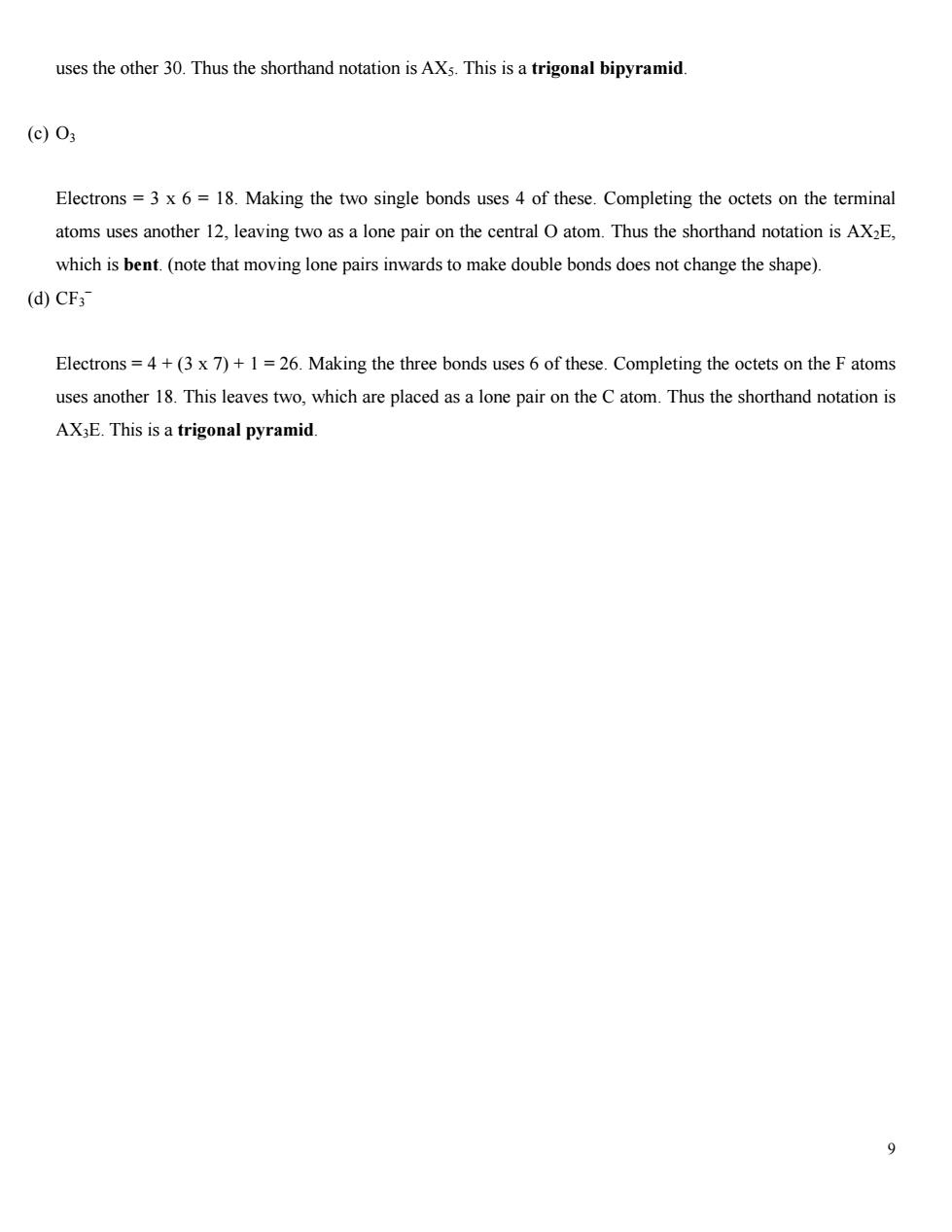
uses the other 30.Thus the shorthand notation is AXs.This is a trigonal bipyramid (c)O3 Electrons=3 x 6=18.Making the two single bonds uses 4 of these.Completing the octets on the terminal atoms uses another 12,leaving two as a lone pair on the central O atom.Thus the shorthand notation is AXE. which is bent.(note that moving lone pairs inwards to make double bonds does not change the shape) (d)CF3 Electrons=4+(3x 7)+1=26.Making the three bonds uses 6 of these.Completing the octets on the F atoms uses another 18.This leaves two,which are placed as a lone pair on the C atom.Thus the shorthand notation is AX3E.This is a trigonal pyramid
9 uses the other 30. Thus the shorthand notation is AX5. This is a trigonal bipyramid. (c) O3 Electrons = 3 x 6 = 18. Making the two single bonds uses 4 of these. Completing the octets on the terminal atoms uses another 12, leaving two as a lone pair on the central O atom. Thus the shorthand notation is AX2E, which is bent. (note that moving lone pairs inwards to make double bonds does not change the shape). (d) CF3 − Electrons = 4 + (3 x 7) + 1 = 26. Making the three bonds uses 6 of these. Completing the octets on the F atoms uses another 18. This leaves two, which are placed as a lone pair on the C atom. Thus the shorthand notation is AX3E. This is a trigonal pyramid